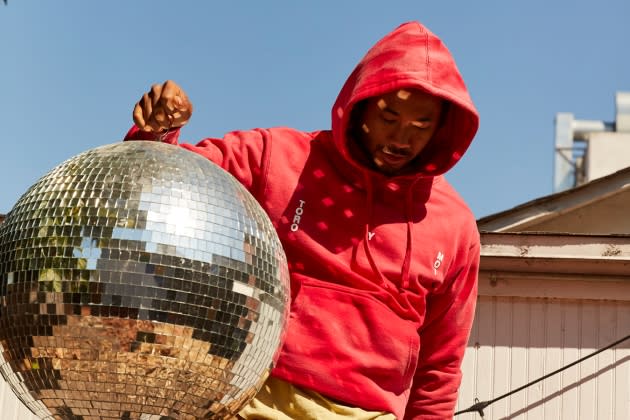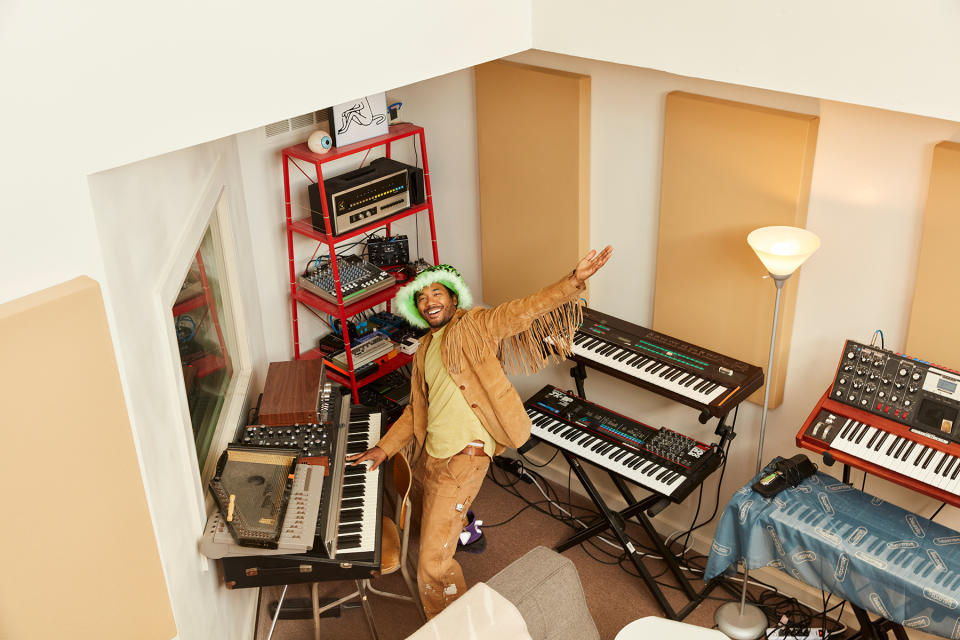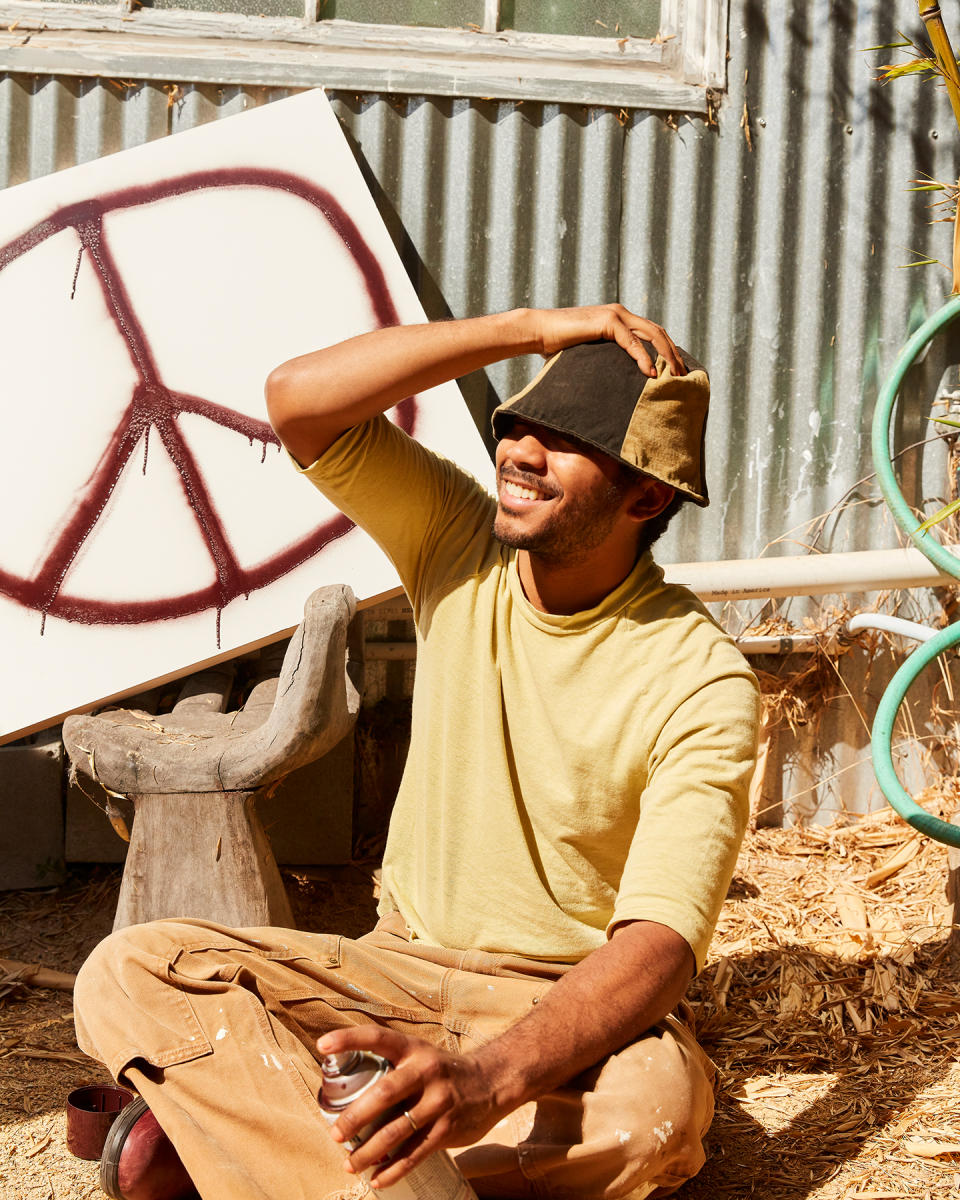How a ‘Loud, Psychedelic’ Ride Helped Bring Toro y Moi’s World into Focus

All Chaz Bear wanted was a vehicle. By early January 2021, he’d spent ten months cloistered in his home studio in Oakland, California, putting the finishing touches on his seventh album as Toro y Moi, and the time had come to think about a way of presenting it to the world in an ongoing pandemic. “Say, hypothetically, I can’t play venues,” he remembers asking himself. “What are you gonna do?” His mind turned to transportation — something guerrilla, preferably open-air — so he went to eBay and typed in “jeep.” Between the large-tread off-roaders and beach cruisers, Bear stumbled on a familiar silhouette, half-Humvee, half-Furthur bus: a riot of blue and lavender, with a cabin that could seat at least 12. It was a jeepney. “It was the only one,” he says, still in disbelief more than a year later. “It feels like finding a soulmate.”
Bear, 35, recognized it instantly as a potent symbol of creative resilience and shared history. “Just thinking about the story of this thing — being an American tool for war, repurposed, and then turned into art — is really powerful,” he says. As the U.S. withdrew troops from the Philippines after World War II, its military left behind thousands of surplus utility vehicles. Enterprising Filipino welders experimented with the discarded auto parts over the subsequent decades, a gradual process that began with functional modifications but took a florid turn as the jeepney spread, combining design elements from popular American cars of the 1950s and street art. (The name is a portmanteau of “jeep” and “jitney.”) Today, jeepneys are the primary mode of mass transit throughout the Philippines, with hand-painted exteriors that showcase their drivers’ individual personalities, as filmmaker Esy Casey illustrates in her dazzling 2013 documentary Jeepney. They are, essentially, a community good with a hot rod culture.
More from Rolling Stone
Toro y Moi Showcases Groove-Laden Track 'Millennium' on 'Fallon'
Toro y Moi's Sunglasses Collab Was Inspired by the Mood Board for His Latest Album
Toro y Moi and Friends Speed Around San Francisco in 'The Loop'
Growing up in suburban South Carolina in the Nineties, Bear kept a miniature jeepney on a shelf in his bedroom — a gift from his mother, who had immigrated to the United States from the Philippines when she was a teenager. Taking in stories about her childhood home, Bear would gaze at the toy and dream about what it might be like to experience the real thing. Finding one on this side of the Pacific Ocean (that had survived almost half a century with less than 1,500 miles and its original paint job) felt “cosmically poignant,” he says. “Like it just had to happen.”
A week later, he was standing in a Best Buy parking lot accepting its delivery. “I can’t drive stick,” he admits with a laugh, so his wife, Sam, agreed to pilot his very first jeepney ride. “I’m in the passenger seat like, ‘What the fuck?’ I immediately felt the magic of it.”

Keeping with the customs of jeepney ownership, Bear gave his a name: MAHAL, an elastic Tagalog word which translates to “love” or “expensive” depending on its context, but ultimately signifies tremendous value. He gave the same name to the album he was finishing, a smoldering ode to 1970s soul, psych-rock, and guitar music worldwide, synthesized with the genre-blending virtuosity that has become his signature. The longer the jeepney was in his care, the further it seemed to merge with the album, to the point where Bear even wove recordings of the vehicle’s six-month restoration process into the tracklist. “It totally filled the space of what I was envisioning,” he says. “It’s loud, it’s psychedelic. It’s actually from the Seventies. Like, this is the sound.”
“Loud and psychedelic” isn’t exactly how I’d describe Bear when he and I meet on a hazy June morning on New York’s Lower East Side. He’s dressed almost entirely in black — Patagonia Baggies, a shacket, some kind of gorpy trail sneaker. Still, my eyes are drawn to his chrome gel manicure, which catches the light with each conversational gesture. As we chat about Yelp reviews and NFTs, he mentions that all of his belongings for this New York trip fit in the tote bag on his shoulder. I’m reminded of the multi-day camping festival he’ll host in late September, nestled in the forests of Big Sur with limited wi-fi and spotty cell service. Any small tensions I observe in these first moments with Bear — between the physical and digital, the resplendent and restrained — echo a comfort with paradox that permeates his music.
One of the first Toro y Moi records to garner broad attention, more than a decade ago, was “Talamak,” a glitchy, dreamy melange about heartache and longing that Bear cooked up in his college bedroom, pulling from J Dilla and Pinkerton in equal measure. It was an instant favorite of the late-aughts music blogs — in 2009, Kanye West posted the track to his now-defunct KanyeUniverseCity with a note that read: “LISTEN TO THIS GOOD SHIT” — and helped to catapult Bear forward as a pioneer of the emergent “chillwave” sound. The song’s title is another Tagalog word with varied translations (“chronic,” “addicted,” “rampant,” “soaked through”), and for Bear, those early days are dotted with memories of explaining its linguistic origins, either in interviews or to his peers. “Just to have that small amount of validation was all I was seeking,” he says. “I just wanted to be seen as Filipino.”
Bear was born in Columbia, South Carolina, a mid-size Southern college town best known for its football program, the kind of place where it’s unsurprising to find a Confederate flag shot glass. For Bear, who is the eldest son of a Black father and a Filipino mother, developing a cohesive sense of his multiracial identity in this environment was complicated. “I mostly connected with my Filipino culture,” he tells me, “as opposed to my African American culture, which was just always sort of” — he pauses, searching for the word — “overlooked.” “By both me and others,” he adds. Bear attributes this, in some measure, to circumstance: He saw his father’s side only occasionally, while spending most weekends with his mom’s extended family. His maternal grandfather, a major proponent for building Filipino community in the greater Columbia area, would regularly host parties in his home or organize local food pop-ups and enlist his grandson to work the register.
Bear remembers his teenage years as marked by “moments of identity crisis.” While he found community with other kids who, like him, were more interested in perfecting Louie Barletta skate tricks than breaking tackles, Bear describes his younger self as “very much the token Black guy.” “I just didn’t get a chance to really fully express myself and express my Blackness in South Carolina until I could do it through music,” he says, “and it wasn’t until Toro officially came out in 2009 or ’10, when beat heads and hip-hop fans were noticing me.” For Bear, the act of making and sharing music was uniquely affirming. Still, he admits he “didn’t feel the urge to represent” at the time, and instead, paused there, at his own legibility.
In the decade between “Talamak” and MAHAL, Bear found direction in the music of Joe Bataan. After a gig in Philadelphia in 2009, as the bar was closing down, Ryan Kattner, lead singer of the band Man Man, played Bataan’s breezy 1975 single “Ordinary Guy” for Bear over the house speakers. On the chorus, Bataan croons, “I’m just an ordinary, ordinary guy/Afro-Filipino, average sort of guy” — a coyly casual framing of his mixed-race identity, just eight years after Loving v. Virginia overturned race-based legal restrictions on marriage in the United States. (South Carolina was one of the last states to formally repeal its anti-miscegenation laws in 1998; Bear was 12 years old.) “It blew my mind,” Bear says. “I really felt seen.”
Several years later, while hanging out with Freddy Anzures, best known as one of the seven Apple designers who worked with Steve Jobs to create the iPhone, Bear saw Bataan’s Afrofilipino on vinyl for the first time and decided to cover the song. One fall evening in 2019, with Anzures’ help, he met the older musician at pioneering restaurateur Nicole Ponseca’s East Village Filipino gastropub, Jeepney, and played his version of “Ordinary Guy” for Bataan himself. “Building that community was really important,” Bear says, considering his slow but purposeful acceleration to that moment. “It’s important to take those baby steps.”
On Juneteenth 2020, amid a summer of national outcry against systemic racism and police violence toward Black Americans, Bear released his recording of “Ordinary Guy” as a fundraiser for the NAACP Legal Defense Fund. In his announcement, he wrote: “I was immediately hooked by Joe’s music because, to me, he represented the impossible — he felt so comfortable in his skin and he had so much confidence and appeal.” Beyond the money raised, this sentiment — of confidence, of comfort, of actualizing what feels impossible — was what he hoped most to extend with the cover.
Bear traces back that impulse to “a turning point” he came to around 2016, coinciding with starting therapy and having his priorities rearranged by Solange’s “Don’t Touch My Hair,” which he credits as paving the way for his last few releases as Toro y Moi. “I felt like I came to my senses,” he says. “When I was writing sad love songs, that was like a scapegoat at times. ‘Cause it’s the most relatable feeling, everyone can relate to that. But to get even deeper into the weeds? That’s hard.”
Bear’s music is, in part, the product of a lifetime of feeling alienated by strict ideas about identity. His commitment to genrelessness, a tacit refusal of categorization, provides a throughline; his lyrics lean impressionistic, often capable of dual interpretations depending on what you believe about the artist’s worldview, or better yet, your own. (At times his insistence on the universal can swerve toward blind idealism. In 2017, he apologized for a now-deleted series of tweets in which he opined that “racism isn’t the issue… violence is.”) “It’s something you can only notice from experience,” he says, explaining the ambivalence in his music. “You’re like, ‘Man, I feel like this song isn’t for me,’ or something. I felt that so many ways, so many times, from Black and Filipino music. So to take those influences, take those leftovers, and just make my own plate out of that — I had to do that out of survival.”
He’s at his most confrontational on MAHAL’s “Déjà Vu,” which pairs slippery Southern-rock guitars played in reverse with easy, hushed vocals that brush against imperialist massacre (“A Wounded Knee that came unwound”) and discriminatory cultural norms (“A sweet taboo when you made a vow”). Conceptually, the song walks a tightrope between fondness and rebuke, which he likens to “giving a toxic relative a hug.” “How do you show appreciation for the South?” he asks rhetorically. “Like, being born and raised in the South, and showing that you’re pissed, but you don’t hate where you came from?”

The rest of the album hovers around climate grief, the looming presence of social media, and a yearning for people across distance and time. In 2022, these are broadly universal feelings, but presented alongside the jeepney, their acute relevance to Filipinos around the world emerges in relief. The Philippines is, to date, the single country most at risk from the climate crisis; the one whose people are most online; and the geographic origin of one of the world’s largest diasporas, in part because its economy relies heavily on the remittances of overseas workers. The effect is such that, remarkably, MAHAL is at once an overt mirror for a distinctly Filipino experience and an open door to anyone who can relate. “I’ve always wanted to do something like this, but it just needed to be the right sound,” he explains. “I wanted to touch on OPM, you know?”
OPM is an acronym for “Original Pilipino Music,” a name that does almost nothing to describe the genre’s sound — mostly intricate, irreverent pop ballads — but implies quite a lot about the cultural context within which it formed. “It’s like if there was a genre called American Music,” Bear says, thumbing through a stack of CDs I brought from home of the genre’s biggest acts (Hotdog, the Boyfriends, Cinderella), spontaneously singing lines from the titles he recognizes. OPM and its close predecessor, Manila Sound, blossomed in the Philippines in the late 1970s, an era marked by both the martial-law dictatorship of Ferdinand Marcos Sr. and the tremendous civil resistance that led to his ouster in 1986 — history which is urgently relevant today via the May 2022 election of his son, Ferdinand “Bongbong” Marcos Jr., as the country’s seventeenth president. Marcos Sr. rode a wave of ulcerating nationalism into power, harnessing a cultural identity crisis generated by more than 350 years under colonial rule by Spain and the United States for his political benefit and the plunder of as much as $10 billion in stolen wealth. It was during Marcos Sr.’s 14 years of authoritarian rule, extrajudicial killings, and forced disappearances that Bear’s mother immigrated to the U.S. along with her parents and siblings. “They escaped, essentially,” he tells me. “My grandpa was like, ‘We’re getting outta here,’ and he brought them over one at a time. One child a year for five years.”
Since Marcos Jr. was inaugurated in June, the revisionist history campaign that helped elect him has only continued to gain speed. Bear weighs his words on this subject with care: “It just makes me want to be very intentional,” he says. “You also have to understand what they’re going through. It’s very similar to what we’re experiencing in the states as far as the information they’re consuming and who’s actually at risk there.” His words parallel the warning of Filipino journalist and 2021 Nobel Peace Prize winner Maria Ressa: “Americans, look to the Philippines to see a dystopian future created by social media.”
Across the interior roof of Bear’s jeepney is a mural of the American Midwest dappled with tractors, cattle and farmland — vestigial from its former owners, who used the jeepney to shuttle customers around their property in Minnesota. It’s an apt reminder that culture is cumulative, living and nonlinear, layering and layering and layering ad infinitum. Bear had painted over other indicators of the vehicle’s past lives, but not this one, perhaps preferring the idea of this Filipino object discreetly cradling an all-American core.
Of the United States’ largest immigrant groups, Filipinos have the second-highest rate of assimilation, according to one 2008 study — an unsurprising figure given the nearly half-century the Philippines spent as a U.S. colony. After trading $20 million with Spain for the islands (which precipitated the deadly Philippine-American War), U.S. President William McKinley enacted a policy of “benevolent assimilation” under the assumption of Western supremacy. Filipinos were taught that they were U.S. nationals and flooded with images and descriptions of American culture as something of which they were ostensibly a part — or at least, could be with the overhaul of their local government, education, hygiene, and taste. (Meanwhile, to American citizens, Filipinos were characterized through a kaleidoscope of brutally dehumanizing photography, World’s Fair “exhibitions,” and racist political cartoons.)
It’s a history that Bear is still learning about but feels viscerally. “I do think that it’s time we bring [a conversation about] assimilation to the mainstream and normalize it and make people aware that as people of color, Black and brown, we live a duality,” he says, sounding frustrated and unguarded. “It’s no secret, but I don’t think people realize how hard that balance is. It’s just this burden that doesn’t really go away.”
Over the last year, Filipino Americans have witnessed an unprecedented wave of representation in mainstream pop culture, especially in music, with the enormous commercial and critical success of artists like Olivia Rodrigo, H.E.R., and Saweetie, and Bruno Mars’ dominance via Silk Sonic. To most outside of the represented demographic, though, the fact of these musicians’ Filipino identity and the cultural history yoked to it is still largely invisible. There’s a chance this remains true for Bear, but not from lack of trying. Through the promotion of MAHAL, he has already succeeded in sustaining attention for both in spaces it doesn’t often enjoy.
In July, Toro y Moi performed on NBC’s Tonight Show for the very first time. When we speak ahead of the appearance, Bear tells me that he’s planning to perform “Millennium,” a song whose vocal approach is something new he’s been working on: a crooning falsetto he associates with OPM, Joe Bataan, and Paul McCartney. (“The Beatles are so ingrained in Filipino music,” he adds.)
“The thing with Toro,” he says, “like the vocal delivery, even starting with the first record, it’s all bedroom, you know? You don’t want the person next door to hear, or you don’t want the person downstairs to hear. You have these notes in your head, and you want to try to just, like, keep it to yourself.”
He contrasts the style he became known for — first developed in private, on his mom’s two-tape-deck karaoke machine — to other vocalists who might have gotten their start in theater, with stage-ready belts that soar into the balcony. “They learn to project from the start,” he says. “I’m just now starting to project.”
Best of Rolling Stone


